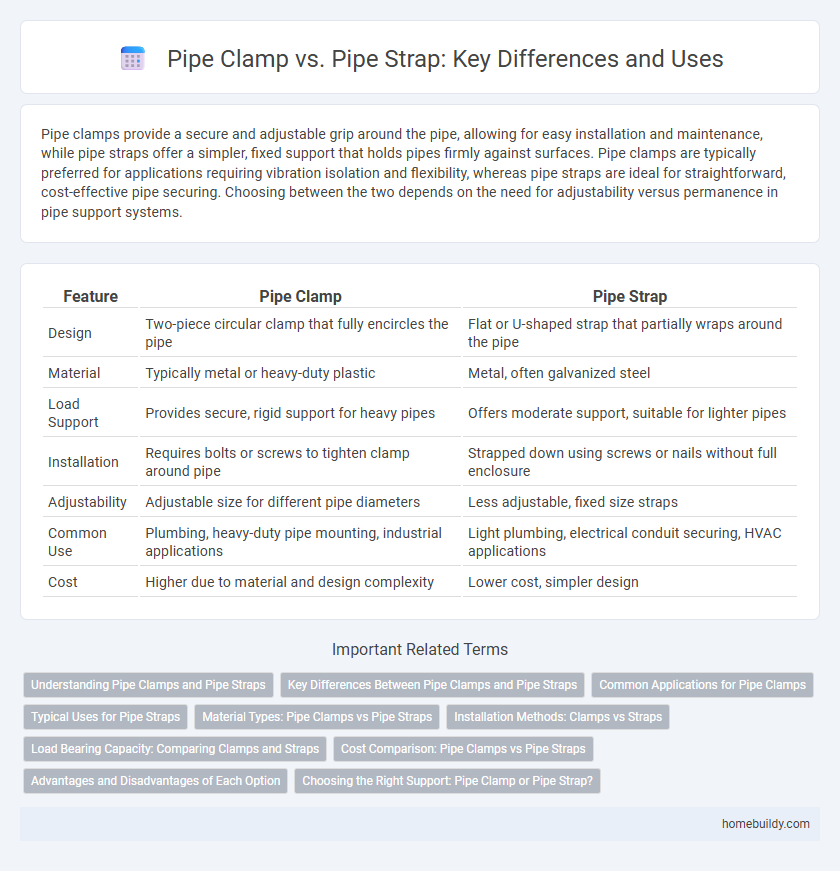Pipe clamps provide a secure and adjustable grip around the pipe, allowing for easy installation and maintenance, while pipe straps offer a simpler, fixed support that holds pipes firmly against surfaces. Pipe clamps are typically preferred for applications requiring vibration isolation and flexibility, whereas pipe straps are ideal for straightforward, cost-effective pipe securing. Choosing between the two depends on the need for adjustability versus permanence in pipe support systems.
Table of Comparison
| Feature | Pipe Clamp | Pipe Strap |
|---|---|---|
| Design | Two-piece circular clamp that fully encircles the pipe | Flat or U-shaped strap that partially wraps around the pipe |
| Material | Typically metal or heavy-duty plastic | Metal, often galvanized steel |
| Load Support | Provides secure, rigid support for heavy pipes | Offers moderate support, suitable for lighter pipes |
| Installation | Requires bolts or screws to tighten clamp around pipe | Strapped down using screws or nails without full enclosure |
| Adjustability | Adjustable size for different pipe diameters | Less adjustable, fixed size straps |
| Common Use | Plumbing, heavy-duty pipe mounting, industrial applications | Light plumbing, electrical conduit securing, HVAC applications |
| Cost | Higher due to material and design complexity | Lower cost, simpler design |
Understanding Pipe Clamps and Pipe Straps
Pipe clamps provide secure and adjustable support by encircling pipes, allowing for easy installation and vibration reduction in plumbing or construction projects. Pipe straps feature a flat, rigid design that holds pipes firmly against a surface, ideal for fixed positioning in electrical or plumbing systems. Selecting between a pipe clamp and a pipe strap depends on the need for flexibility versus permanent stabilization in pipe mounting applications.
Key Differences Between Pipe Clamps and Pipe Straps
Pipe clamps provide strong, adjustable support for piping systems by securely gripping pipes with a tightened mechanism, allowing for precise alignment and vibration reduction. Pipe straps are simpler, fixed fasteners that wrap around pipes to hold them against surfaces, offering less flexibility but easier installation for lightweight or stationary applications. The key difference lies in pipe clamps' ability to allow pipe movement and adjustment, while pipe straps primarily offer rigid, static support.
Common Applications for Pipe Clamps
Pipe clamps are commonly used in plumbing, electrical, and HVAC systems to securely fasten pipes to walls or ceilings, providing stability and vibration dampening. Unlike pipe straps, which mainly offer simple fastening, pipe clamps accommodate slight pipe movement, preventing damage in dynamic environments such as industrial or mechanical installations. Their versatility makes them essential for supporting heavy pipes in commercial and residential construction projects.
Typical Uses for Pipe Straps
Pipe straps are commonly used for securing pipes to walls, ceilings, or wooden surfaces in residential and commercial plumbing installations. They provide stable support for horizontal or vertical piping runs, especially for water, gas, and electrical conduit applications. Their simple design allows for easy installation and removal, making them ideal for light to moderate load-bearing pipe securing tasks.
Material Types: Pipe Clamps vs Pipe Straps
Pipe clamps are typically made from robust materials such as stainless steel, galvanized steel, or heavy-duty plastic, offering superior durability and corrosion resistance for secure pipe mounting. Pipe straps are often manufactured from lighter gauge metals like galvanized steel or aluminum, providing a flexible and cost-effective solution for supporting pipes in less demanding environments. The choice between pipe clamps and pipe straps depends significantly on the material properties required for strength, environmental exposure, and load-bearing capacity.
Installation Methods: Clamps vs Straps
Pipe clamps typically require fastening with bolts or screws around the pipe, allowing adjustable tension and secure support, making them suitable for dynamic or heavy-duty applications. Pipe straps install by mounting flat metal bands against surfaces with screws, offering a simpler, fixed hold ideal for lightweight or non-movable pipes. The clamp's installation method provides greater flexibility and vibration resistance compared to the rigid, straightforward setup of pipe straps.
Load Bearing Capacity: Comparing Clamps and Straps
Pipe clamps typically offer higher load-bearing capacity than pipe straps due to their robust design and secure fastening mechanism, which evenly distributes the weight of the pipe. Pipe straps provide more flexibility for lighter applications but may lack the rigidity required for heavy-duty installations, making them less suitable for supporting substantial loads. Engineers often select pipe clamps over straps in industrial settings where stability and load capacity are critical considerations.
Cost Comparison: Pipe Clamps vs Pipe Straps
Pipe clamps generally have a higher upfront cost compared to pipe straps due to their more complex design and enhanced holding strength. While pipe straps offer a lower price point, they may require more frequent replacement or additional support for heavier pipes, increasing long-term expenses. Choosing between pipe clamps and pipe straps depends on balancing initial budget constraints against durability and maintenance costs over time.
Advantages and Disadvantages of Each Option
Pipe clamps provide superior grip and adjustability for securing pipes, making them ideal for applications requiring frequent repositioning or maintenance. Pipe straps offer a simpler, more cost-effective solution with easier installation but lack the flexibility and strong holding power of clamps. Choosing between the two depends on the need for strength and adjustability versus budget and installation speed.
Choosing the Right Support: Pipe Clamp or Pipe Strap?
Pipe clamps provide secure, adjustable support for pipes, ideal for applications requiring vibration isolation and precise positioning. Pipe straps offer a simpler, fixed fastening solution, best suited for permanent, low-movement pipe installations. Selecting the right support depends on load requirements, environmental conditions, and the need for flexibility or rigidity in pipe securing.
Pipe clamp vs Pipe strap Infographic

 homebuildy.com
homebuildy.com